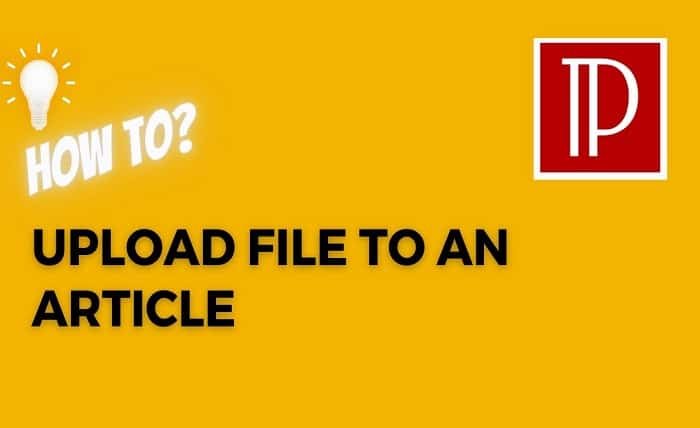Upload an Article Successfully

Introduction
In today’s digital age, knowing how to upload an article efficiently is essential for anyone looking to share their work with a wider audience. Whether you’re a blogger, journalist, or academic, mastering the process of uploading an article can significantly impact its reach and effectiveness. This guide will walk you through the steps required to upload an article successfully, offering tips and insights to help you navigate the process seamlessly.
Choosing the Right Platform
Before you upload an article, it’s crucial to select the right platform. Different platforms cater to different audiences and purposes. For instance, academic articles might be uploaded to research databases or journals, while blog posts are often uploaded to content management systems (CMS) like WordPress or Medium. Understanding your audience and the platform’s requirements will help ensure your article reaches the intended readers.
Preparing Your Article for Upload
Before you upload an article, ensure it is properly prepared. This involves proofreading for grammatical errors, formatting it according to the platform’s guidelines, and ensuring that all necessary metadata, such as keywords and tags, is included. A well-prepared article is more likely to be accepted and perform well once uploaded.
Formatting Your Article
Proper formatting is key when you upload an article. Different platforms have specific formatting requirements, including text alignment, font size, and heading styles. For instance, academic journals might require a specific citation style, while blog platforms may have more flexible formatting options. Adhering to these guidelines helps maintain the professionalism and readability of your article.
Uploading Your Article to a CMS
If you’re uploading an article to a content management system (CMS) like WordPress, the process usually involves logging into your account, navigating to the post or article section, and using the upload function. Most CMS platforms have user-friendly interfaces that allow you to easily upload, edit, and publish your article. Be sure to preview your article before publishing to ensure everything looks correct.
Uploading Your Article to an Academic Journal
Uploading an article to an academic journal involves a more detailed process. Typically, you’ll need to create an account on the journal’s submission portal, fill out required metadata forms, and upload your manuscript file. Many journals use a peer-review system, so be prepared for a review process before your article is officially published.
Troubleshooting Common Issues
When you upload an article, you might encounter various issues, such as file size limitations, compatibility problems, or errors in the submission process. Common troubleshooting steps include checking file formats, ensuring you meet all submission guidelines, and contacting support if you encounter persistent problems. Addressing these issues promptly helps ensure a smooth upload process.
Optimizing Your Article for Search Engines
To maximize the reach of your article, consider optimizing it for search engines before you upload it. This involves including relevant keywords, writing compelling meta descriptions, and using SEO best practices. By doing so, you increase the chances of your article being discovered by a broader audience through search engines.
Promoting Your Uploaded Article
After you upload an article, promotion is key to reaching a wider audience. Share your article on social media platforms, email newsletters, and relevant forums to increase its visibility. Engaging with your audience through comments and discussions can also drive more traffic to your article.
Monitoring the Performance of Your Article
Once your article is uploaded, monitoring its performance is crucial for understanding its impact and reach. Most platforms provide analytics tools that track metrics such as views, engagement, and reader demographics. Analyzing this data can help you refine your content strategy and improve future articles.
Legal and Ethical Considerations
When you upload an article, be aware of legal and ethical considerations. This includes ensuring that you have the right to use all included content, properly citing sources, and adhering to copyright laws. Understanding these considerations helps avoid potential legal issues and maintains the integrity of your work.
Conclusion
Knowing how to upload an article effectively involves several key steps, from choosing the right platform and preparing your content to formatting, uploading, and promoting your work. By following the guidelines outlined in this comprehensive guide, you can ensure that your article reaches its intended audience and performs well. Stay informed about best practices and continuously monitor the performance of your uploads to maximize their impact.
FAQs
1. What should I do before uploading an article?
Before you upload an article, ensure it is thoroughly proofread, formatted according to platform guidelines, and includes all necessary metadata such as keywords and tags.
2. How do I choose the right platform to upload my article?
Select a platform based on your target audience and the purpose of your article. Academic articles typically go to journals or research databases, while blogs and general content are suited for CMS platforms like WordPress.
3. What common issues might I face when uploading an article?
Common issues include file size limitations, format compatibility problems, and submission errors. Check file formats, adhere to submission guidelines, and contact support if problems persist.
4. How can I optimize my article for search engines?
Optimize your article by including relevant keywords, writing a compelling meta description, and following SEO best practices to improve visibility and reach.
5. What legal considerations should I keep in mind when uploading an article?
Ensure that you have the rights to all content used, properly cite sources, and adhere to copyright laws to avoid legal issues and maintain the integrity of your work.





